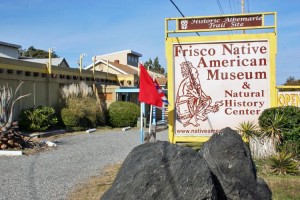Here comes summer! Visitors are returning to Hatteras Island for longer stays, many with extended families and school age children, and finding this a wonderful place and time for fun, relaxation and even learning.
One of the best opportunities for visitors of all ages to learn about Hatteras Island and its connection to other communities and cultures is at the Frisco Native American Museum and Natural History Center. The museum, located on Highway 12 next to the Frisco post office, has been in operation as a non-profit educational foundation since 1987. The brain child of two educators, husband and wife team Carl and Joyce Bornfriend, the museum showcases Carl’s personal collections of Native American artifacts in a carefully designed setting that features the natural ecology and history of Hatteras Island. Over the years, the building has served as a general store, post office and shell shop. Now it is arranged as a series of exhibit spaces with special emphasis on the Hopi, Navaho and other North American Indian tribes. Land for a nature trail was acquired in 1989, and a pavilion was constructed on the trail just in time for Hurricane Emily to bring three feet of water through the entire facility in 1992.
Today the museum focuses on the early Native Americans who inhabited Hatteras Island by recreating aspects of their culture and life style. The remains of an ancient log canoe found on the property as well as material from early people’s middens (trash heaps) have been of interest to East Carolina University archeologists who continue to collaborate with the museum curators in their on-going projects. These studies are being accomplished with the help of volunteers who are currently digging postholes for the construction of a long house in anticipation of creating an accurate interpretation of a Native American village.
To assist in this effort the museum has brought in Ronnie Francisco as the new assistant director. Ronnie is a member of the Mohawk Nation at Akwesasne, New York, and is knowledgeable about ancient Native American religious and cultural practices. As a former volunteer herself, Ronnie is enthusiastic about her job. “We are hoping to reinstate the tradition of a pow-wow which the museum hosted in years past,” says Ronnie. “By next April, we’d like to have the public join us for Village Days, an activity that shows the integration of the Native American people who once lived here with the ecology and natural history of this amazing setting.”
So put everyone in the car and head to the Frisco Native American Museum and Natural History Center for a look at beautiful objects, an interesting nature walk, and an introduction to an interesting and important part of the history of Hatteras Island.
